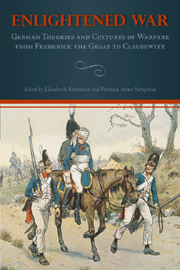Book contents
- Frontmatter
- Contents
- List of Illustrations
- Acknowledgments
- Introduction: Enlightened Warfare in Eighteenth-Century Germany
- Part I War and Enlightenment
- Part II Cultures of War in Classicism and Romanticism
- Part III War and Gender
- 7 On Gender Wars and Amazons: Therese Huber on Terror and Revolution
- 8 Angelica Kauffmann's War Heroes: (Not) Painting War in a Culture of Sensibility
- 9 Citizen-Soldiers: General Conscription in the Nineteenth and Twentieth Centuries
- Part IV War and Theory
- Bibliography
- Notes on the Contributors
- Index
8 - Angelica Kauffmann's War Heroes: (Not) Painting War in a Culture of Sensibility
from Part III - War and Gender
Published online by Cambridge University Press: 05 February 2013
- Frontmatter
- Contents
- List of Illustrations
- Acknowledgments
- Introduction: Enlightened Warfare in Eighteenth-Century Germany
- Part I War and Enlightenment
- Part II Cultures of War in Classicism and Romanticism
- Part III War and Gender
- 7 On Gender Wars and Amazons: Therese Huber on Terror and Revolution
- 8 Angelica Kauffmann's War Heroes: (Not) Painting War in a Culture of Sensibility
- 9 Citizen-Soldiers: General Conscription in the Nineteenth and Twentieth Centuries
- Part IV War and Theory
- Bibliography
- Notes on the Contributors
- Index
Summary
THROUGHOUT THE TWENTIETH CENTURY female artists have represented wars both at home and abroad. Käthe Kollwitz's print “Nie wieder Krieg” (1924, Never Again War) ranks among the most widely reproduced antiwar pieces. Recent scholarship has drawn attention to a number of important women artists in the Age of Enlightenment including the Italian and French painters Rosalba Carriera and Elisabeth Vigée-Lebrun and the English sculptor Anne Seymour Damer, but engagement with war seems to be rare. In a letter from 6 June 1793 to Johann Heinrich Meyer (1755–1829), Angelica Kauffmann, one of the most prominent painters of her time and an active member of the international Roman artist community, casually defined the relation between art and war. In an ironic mode, she mentioned to Meyer, the Swiss art historian and painter in Weimar, that a mutual friend “theilt nun seine Zeit zwischen Mars und den Musen, die sich sonsten nicht wohl zusammen schicken” (is now dividing his time between Mars and the Muses, two realms that do not normally mesh well). The friend in question is none other than Johann Wolfgang Goethe, with whom the painter had become friends during his sojourn in Rome. The reference to Mars pertains to Goethe's participation in the military campaign in France and his presence at the siege of Mainz (14 April to 23 July 1793) as a companion and loyal subject of Duke Carl August of Weimar.
- Type
- Chapter
- Information
- Enlightened WarGerman Theories and Cultures of Warfare from Frederick the Great to Clausewitz, pp. 192 - 218Publisher: Boydell & BrewerPrint publication year: 2011

